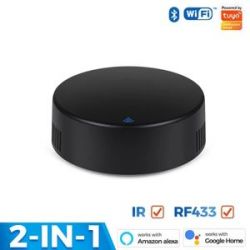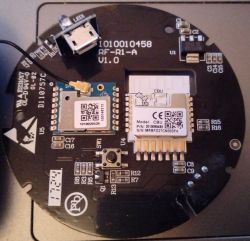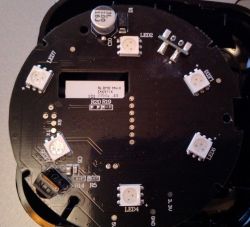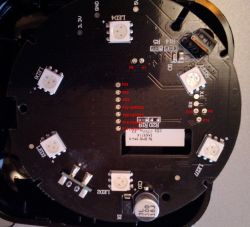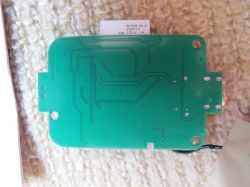Pinout:
| CBU Pin | BK7231N | Function | Board TP | 1 | P14 (SPI_SCK) | SH4 CLK | SCK | 2 | P16 (SPI_MOSI) | SH4 SDIO via R9 | 3 | P20 | SH4 GPIO1 | INT1 | 4 | P22 | SH4 GPIO2 | INT2 | 5 | ADC | Button via RC network | ADC | 6 | RX2 | 7 | TX2 | 8 | P8 | IR receiver | 9 | P7 | IR tx | 10 | P6 | 11 | P26 | 12 | P24 | 13 | GND | GND | GND | 14 | 3V3 | 3V3 | 3V3 | 15 | TX1 | TXD | 16 | RX1 | RXD | 17 | P28 | 18 | CEN | CEN | 19 | P9 | Status LED | 20 | P17 (SPI_MISO) | 21 | P15 (SPI_CS) | CSN |
The button is connected to ADC via a RC network:
![[CBU/BK7231N and SH4/CMTOV30] Wi-Fi IR+RF Remote Control (S11) [CBU/BK7231N and SH4/CMTOV30] Wi-Fi IR+RF Remote Control (S11)](https://obrazki.elektroda.pl/7536390400_1683260238_thumb.jpg)
As the IR section is identical to the well-covered S08 at https://www.elektroda.com/rtvforum/topic3920360.html I'm mainly focusing on the RF section.
According to https://developer.tuya.com/en/docs/iot/sh4-module-datasheet?id=Ka04qyuydvubw the SH4 module is based around a CMTOV30-EQR chip. While I was not able to find information on this chip, CMOSTEK's CMT2300 has a suspiciously similar part number (CMT2300A-EQR) and the same pinout. Looking at the SPI traffic it looks like the register map is the same as well.
The SH4 is connected to the CBU via 2 interrupt lines, 2 chip select lines, a clock line, and a bi-directional data line. Although the datasheet for the CMT chip says it can do SPI at 5 MHz, the CMU is only moving data at approximately 500 kHz. Looking at it with a logic analyzer it looks like they might be bit-banging the data instead of using the hardware SPI peripheral as the frequency changes slightly between sending and receiving:
![[CBU/BK7231N and SH4/CMTOV30] Wi-Fi IR+RF Remote Control (S11) [CBU/BK7231N and SH4/CMTOV30] Wi-Fi IR+RF Remote Control (S11)](https://obrazki.elektroda.pl/1991969400_1683212266_thumb.jpg)
SPI traffic on boot:
That's about as far as I've gotten so far. It looks like using this RF chip involves a whole lot of copying and pasting.







![[CBU/BK7231N and SH4/CMTOV30] Wi-Fi IR+RF Remote Control (S11) [CBU/BK7231N and SH4/CMTOV30] Wi-Fi IR+RF Remote Control (S11)](https://obrazki.elektroda.pl/6465587400_1683207427_thumb.jpg)
![[CBU/BK7231N and SH4/CMTOV30] Wi-Fi IR+RF Remote Control (S11) [CBU/BK7231N and SH4/CMTOV30] Wi-Fi IR+RF Remote Control (S11)](https://obrazki.elektroda.pl/2074330900_1683207427_thumb.jpg)
![[CBU/BK7231N and SH4/CMTOV30] Wi-Fi IR+RF Remote Control (S11) [CBU/BK7231N and SH4/CMTOV30] Wi-Fi IR+RF Remote Control (S11)](https://obrazki.elektroda.pl/3616818800_1683207435_thumb.jpg)
![[CBU/BK7231N and SH4/CMTOV30] Wi-Fi IR+RF Remote Control (S11) [CBU/BK7231N and SH4/CMTOV30] Wi-Fi IR+RF Remote Control (S11)](https://obrazki.elektroda.pl/1958539600_1683207431_thumb.jpg)
![[CBU/BK7231N and SH4/CMTOV30] Wi-Fi IR+RF Remote Control (S11) [CBU/BK7231N and SH4/CMTOV30] Wi-Fi IR+RF Remote Control (S11)](https://obrazki.elektroda.pl/2034002100_1683207431_thumb.jpg)
![[CBU/BK7231N and SH4/CMTOV30] Wi-Fi IR+RF Remote Control (S11) [CBU/BK7231N and SH4/CMTOV30] Wi-Fi IR+RF Remote Control (S11)](https://obrazki.elektroda.pl/4587106300_1683207427_thumb.jpg)
![[CBU/BK7231N and SH4/CMTOV30] Wi-Fi IR+RF Remote Control (S11) [CBU/BK7231N and SH4/CMTOV30] Wi-Fi IR+RF Remote Control (S11)](https://obrazki.elektroda.pl/4582526600_1683207430_thumb.jpg)
![[CBU/BK7231N and SH4/CMTOV30] Wi-Fi IR+RF Remote Control (S11) [CBU/BK7231N and SH4/CMTOV30] Wi-Fi IR+RF Remote Control (S11)](https://obrazki.elektroda.pl/9864367000_1683261398_thumb.jpg)
![[CBU/BK7231N and SH4/CMTOV30] Wi-Fi IR+RF Remote Control (S11) [CBU/BK7231N and SH4/CMTOV30] Wi-Fi IR+RF Remote Control (S11)](https://obrazki.elektroda.pl/6142094500_1683261399_thumb.jpg)
![[CBU/BK7231N and SH4/CMTOV30] Wi-Fi IR+RF Remote Control (S11) [CBU/BK7231N and SH4/CMTOV30] Wi-Fi IR+RF Remote Control (S11)](https://obrazki.elektroda.pl/5604144100_1683261398_thumb.jpg)
![[CBU/BK7231N and SH4/CMTOV30] Wi-Fi IR+RF Remote Control (S11) [CBU/BK7231N and SH4/CMTOV30] Wi-Fi IR+RF Remote Control (S11)](https://obrazki.elektroda.pl/7121175000_1685166633_thumb.jpg)
![[CBU/BK7231N and SH4/CMTOV30] Wi-Fi IR+RF Remote Control (S11) [CBU/BK7231N and SH4/CMTOV30] Wi-Fi IR+RF Remote Control (S11)](https://obrazki.elektroda.pl/1521314300_1685166640_thumb.jpg)
